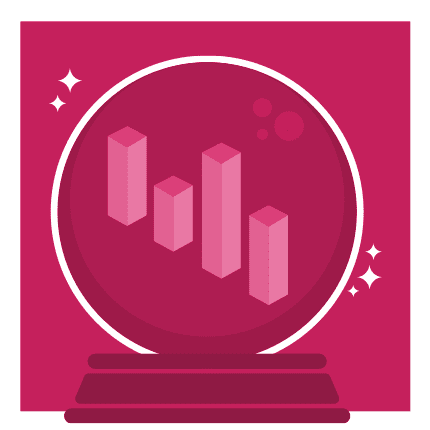Predictive analysis is often applied to manage supply chains and business operations and to analyze consumer behavior. According to Statista.com, predictive analysis is here to stay with a value of $5.29 billion in 2020, and is forecast to grow to $41.52 billion by 2028.
But what is it? How can it positively impact your business and marketing strategies? Let’s find out.
What is Predictive Analysis?
Predictive analysis is a form of business analysis that uses statistics or machine learning to predict the outcome of something. That something can be anything from consumer intent and customer lifetime value to sales trends.
Compared to other types of business analysis, while predictive analysis focuses on what is likely to happen, descriptive analysis looks at what has happened. Prescriptive analysis seeks answers based on the other two analytics to determine what should happen – according to what has happened and what is likely to happen.
Predictive analysis can be used to:
- Forecast future customer churn rates.
- Accurately predict future sales forecasts.
- Enable businesses to order the optimal amount of inventory to meet customer demand.
- Calculate a customer’s lifetime value (CLV).
- Predict what products a customer is likely to buy in the future.
- Prevent logistics or warehouse equipment malfunctions.
What Are Methods of Predictive Analysis?
Harnessing current and/or historical data with statistical techniques like predictive modeling, deep learning algorithms, machine learning, and data mining, predictive analysis can forecast future likely events.
Other types of predictive analysis techniques include:
- Data warehousing (such as SQL analytics databricks) forms the foundations of large-scale data mining projects.
- Data clustering uses machine learning to group objects into categories based on similarities, such as audience segmentation based on past engagement.
- Classification is a prediction technique that involves calculating the probability that an item belongs to a particular category.
- Logistic regression finds correlations between inputs and outputs.
- Decision trees are supervised learning algorithms used to determine courses of action and the probabilities associated with each, depending on sets of variables.
- Neural machine translation networks are typically used for data classification purposes through input and output nodes.
- Time series analysis is a technique used for analyzing time-series data, such as changes over periods.
What is a Predictive Analysis Example?
A good use case for predictive analysis is in the eCommerce space – specifically product recommendations. Smart algorithms create accurate projections for consumers based on what they’ve previously bought and other contextual reasons.
One example of these algorithms in practice involves looking at the purchase and reviewing the history of the consumer and recommending products on similar user data. Any products that the user has previously purchased would be disregarded.
Brands seeking to improve customer engagement and conversion rates often garner great results from recommendation engines. Done right, this predictive analysis marketing strategy encourages upsells and cross-sells, establishes brand loyalty, and ensures the customers return for more.
The Role of Predictive Analysis in Marketing
Personalized Experiences
Predictive analysis forms the backbone of winning marketing strategies. This is because using data in the right way enables personalized customer experiences and drives sales. In marketing, needs forecasting is a widely used predictive analytics tool, where businesses anticipate customer needs based on their web browsing habits.
For instance, online home renovation retailers can predict when a customer is in the market for decorating products due to increased searches for home improvements.
Solving Problems
Predictive analysis solves customer problems before they are aware that they have problems. Using customer intent and behavior data, businesses can see which customers are more at risk of churn and act accordingly, even if they have a PandaDoc convertible note agreement template in place. Proactively addressing potential issues is a good business position to be in and minimizes the impact on the overall customer experience.
New Customer Acquisition
Use data segmentation as predictive analysis to define customer identification models. This practice works by identifying potential customers based on your existing customers’ needs, wants, purchase behavior, and preferences.
Optimize Marketing Budget
Predictive analysis enables marketers to spend budgets more effectively – whether the goal is to convert potential customers, attract a new audience segment, or retain existing customers. Because predictive analysis can help you understand the actions of users that indicate their conversion intentions, you can craft relevant landing pages, sales funnels, and marketing campaigns that are poised to positively impact your bottom line.
The Predictive Analysis Marketing Process
How could predictive analysis look in your business?
- Define what question you want to answer – e.g. which prospects are likely to sign up for my service within the next 30 days?
- Gather the data – our example needs historical prospects data (specifically how much time it took past prospects to convert), demographic and channel data, plus a current list of prospects.
- Undertake descriptive analysis to determine facts, such as whether the average conversion time varies between channels and whether demographics correlate with these time frames.
- Use statistical techniques to test your theories.
- Create a predictive model after your test discoveries to predict outcomes.
- Deploy the predictive model to glean actionable insights, e.g., the prospects that will likely sign up within the next 30 days.
- Create targeted marketing strategies with these prospects in mind in the hope of maximum conversions.
- Update the predictive model regularly to meet new requirements.
Remember that external influences can skew your data – think about seasonal changes, news events, global crises, etc.
How to Maximize Success in Marketing with Predictive Analysis
Some critical tips to use predictive analysis to its best effect include:
- Gather as much of the right data as possible.
- Decide on the most relevant modeling techniques and algorithms for the specific project.
- Have processes to reduce potential biases.
We Predict That Predictive Analysis is the Future of Marketing
Predictive analysis is fast becoming a vital decision-making tool for forward-thinking businesses. Regardless of industry, predictive analysis can give you the insights you need to drive your marketing. By enabling intelligent data for science collection and harnessing it to accurately predict future outcomes, organizations use predictive analysis to make extremely profitable decisions.




